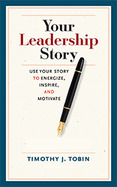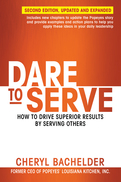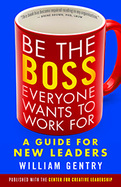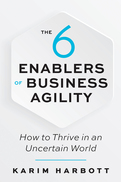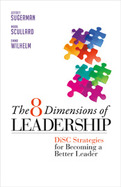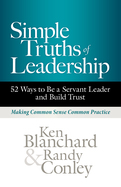Using story as both a metaphor and a process for self-development, Tobin offers activities and questions that help you better understand your own leadership and how others perceive it. What is the plot of your leadership story-your overall goals and purpose? Who are the main characters and what roles do they play? How have the settings of your story influenced it? What are the conflicts that you need to resolve to move toward the ending you intend?
But you have to share your story to make it an effective leadership tool. Tobin gives detailed advice on framing your message, finding ways to communicate it, and understanding the role others play in furthering that message.
If you don't tell your leadership story, other people will-and it may not be the story you want told. Taking control of your leadership story enables you to more consciously shape the impact you have in the world. You'll be better equipped to make decisions, choose actions that tell the story you want to tell, make stronger connections to those you lead, and ensure that you become the kind of leader you want to be.
2018
In this updated edition of Dare to Serve, former Popeyes CEO Cheryl Bachelder shows that leading by serving is a rigorous and tough-minded approach that yields the best results.
When she was named CEO of Popeyes in 2007, the stock price had slipped from $34 in 2002 to $13. The brand was stagnant, the team was discouraged, and the franchisees were just plain angry. Nine years later, restaurant sales were up 45 percent, restaurant profits had doubled, and the stock price was over $61. Servant leadership is sometimes derided as soft or ineffective, but this book confirms that challenging people to reach a daring destination, while treating them with dignity, creates the conditions for superior performance.
The second edition of this bestselling book includes Bachelder's post-Popeyes observations and new examples of how you can switch your leadership from self to serve. Ever engaging and inspirational, Bachelder takes you firsthand through the transformation of Popeyes and shows how anyone, at any level can become a Dare-to-Serve leader.
You've been promoted to leadership—congratulations! But it's nothing like your old job, is it? William Gentry says it's time to flip your script.
We all have mental scripts that tell us how the world works. Your old script was all about “me”: standing out as an individual. But as a new leader, you need to flip your script from “me” to “we” and help the group you lead succeed. In this book, Gentry supports and coaches you to flip your script in six key areas. He offers actionable, practical, evidence-based advice and examples drawn from his research, his work with leaders, and his own failures and triumphs of becoming a new leader. Get started flipping your script and become the kind of boss everyone wants to work for.
Many managers struggle to install the underlying organizational operating system for business agility. High-performing agile organizations depend on the strength of six key enabling factors: leadership, culture, structure, people, governance, and ways of working. This book explains why these factors are important and how they work together to increase organizational agility. Real-world examples, stories, and tools will help leaders get realistic about the scope of changes needed in their organizations and show them how to get started.
Karim Harbott does not offer a book of recipes. Instead, he focuses on mindset, principles, and general patterns. This book summarizes of the most important factors in increasing organizational agility and why they work, which leaders will need to consider in a so-called agile transformation. Because every organization is different, each will have its own route to agility and high performance. Managers will need to tackle all the areas that are crucial to creating an environment in which any chosen approach can work.
-
Employs the latest version of the DiSC system--one of the most widely trusted personality assessments used in business today
-
Stengthens your leadership by both helping you understand your own style and showing what you can learn from other styles
-
Includes leadership assessments you can take online
- Click here for Press Release
Nobody is really prepared to be a leader, In fact, many leaders never even planned on becoming one--it was just the next logical step in their careers. That's why there are so many books on leadership. So why one more? Because too many books take too narrow a view. They tell you to focus on your particular strength, which is only a part of the story. What you really need is a broad perspective on all behaviors needed to be an effective leader.
The 8 Dimensions of Leadership offers both. Based on the recently developed third generation of the DiSC personality assessment--one of the oldest, most widely used, and most scientifically validated tools available--it identifies eight individual leadership styles. By taking a basic version of this assessment online, you can find out if you are a Pioneering, Energizing, Affirming, Inclusive, Humble, Deliberate, Resolute, or Commanding leader. The authors help you understand the psychological drivers, motivations, and "blind spot" characteristic of each style.
But no one style will take youy all the way. A Humble leader may have a hard time making tough decisions. A Commanding leader may run roughshod over people who could be allies. After another assessment to point out the specific areas you need to work on, the authors detail the lessons all leaders can learn from each style. You may always be essentially a Deliberate leader, but to succeed you need to know when you should be a little more Pioneering. This book shows you how to develop a truly multidimensional leadership approach.
After reading The 8 Dimensions of Leadership, you will be able to craft your own approach to leadership--exploring the strengths and challenges of all eight leadership styles--to become the leader you aspire to be.
Effective leadership is an influence process where leaders implement everyday, commonsense approaches that help people and organizations thrive. Yet somehow, many of these fundamental principles are still missing from most workplaces. In Simple Truths of Leadership, legendary servant leadership expert Ken Blanchard, whose books have sold millions of copies worldwide, and his colleague Randy Conley, known and recognized for his many years of thought leadership and expertise in the field of trust, share fifty-two Simple Truths about leadership that will help leaders everywhere make commonsense leadership common practice.
Readers will discover profound, memorable, and in some cases counterintuitive leadership wisdom such as
• Who should make the first move to extend trust
• What role a successful apology plays in building trust
• When to use different strokes (leadership styles) for different folks—and for the same folks
• Where the most important part of leadership happens
• How to create autonomy through boundaries
• Why the key to developing people is catching them doing something right
A fun, easy read that will make a positive difference in leadership and organizational success, Simple Truths of Leadership will show readers how to incorporate simple but essential practices into their leadership style, build trust through servant leadership, and enhance their own lives and the lives of everyone around them.


